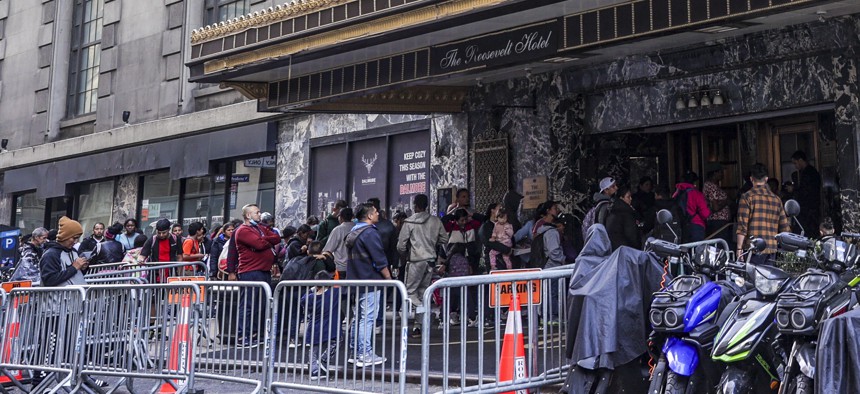Housing
Adams’ proposed changes to right to shelter would not be limited to migrant crisis
The city wants the court to relieve it of the right to shelter mandate whenever the homeless population spikes amid a state of emergency.

Asylum seekers wait outside the Roosevelt Hotel, a city-run shelter for migrant families arriving in New York City. Selcuk Acar/Anadolu Agency via Getty Images
Mayor Eric Adams is seeking to modify the longstanding right to shelter in New York City in light of the “unprecedented” challenges posed by the influx of more than 122,700 asylum-seekers since last spring – roughly half of whom are still being provided shelter and other resources by the city today.
But the language that the administration is asking to add to the relevant consent decree would not be limited to the migrant crisis. If granted by a judge, the proposed changes as written would seem to allow the city to suspend the right to shelter for single adults during other emergencies that lead to major spikes in demand for shelter. The proposed changes would not only apply to migrants, but to all single adults seeking shelter.
“The migrant crisis is – for lack of a more dignified description – it's window dressing,” said Chris Quinn, the president and CEO of shelter provider Win and the former speaker of the New York City Council. “They don't say in this, ‘Relieve us of obligation for three months, and then we'll come back to the court. Relieve us of obligation for six months, and then we'll come back to the court.’ No, they asked to be permanently relieved of this obligation that has helped define the city for four decades.”
Adams and his administration have argued that the decades-old consent decree, which is the foundation of the right to shelter in New York City, was not intended to be an open invitation from the city to shelter the world at large. The administration first filed to amend the consent decree in May and has been in negotiations for months with the state and the Legal Aid Society, which represents homeless New Yorkers.
This week, the Adams administration outlined an updated request to modify the 1981 consent decree in Callahan v. Carey for single adults so that the city will be relieved of its right to shelter obligations whenever two conditions are met: the mayor or governor has declared a state of emergency, and for a period of at least two weeks, the daily number of single adults seeking shelter is at least 50% greater than it was before the declared emergency (averaged over the most recent two-year period).
In a press briefing on Wednesday, New York City Chief Counsel Lisa Zornberg suggested that the city is only asking for temporary relief. “I think the question was, would things roll back to the way they were before this crisis if and when the crisis comes to an end? What I would say, again, without going beyond what’s in our letter, is that we have sought temporary relief to meet the needs of today and this present crisis,” she said. “We have not sought permanent change or termination of the Callahan decree.”
But there is nothing in the language of the administration’s request that specifically limits the desired relief to this present migrant crisis. Asked about this, a City Hall spokesperson replied that Zornberg was saying that the city isn’t seeking to terminate the Callahan consent decree in full, but is seeking relief for emergencies like what the city is experiencing now.
The city’s letter to the judge – which is not actually a motion but a letter describing the motion the city would like to make – does not make clear whether the proposed formula for shelter demand is based on the total daily population of people already in shelter or the daily number of people seeking to enter shelter.
In a press briefing on Wednesday morning, Legal Aid staff attorney Josh Goldfein blasted the city’s request. Asked about his interpretation of the formula, Goldfein called the city’s letter “poorly drafted.” “Words matter here. This is a consent decree that has been carefully studied and examined and litigated for decades,” Goldfein said. “What matters is what do the words say. And if the words don’t make any sense, or if they cause an outcome that is harmful to people, it's not going to matter what they said or what they thought it meant.”
Asked at the Wednesday afternoon press briefing about specific figures that would trigger relief from the right to shelter, Zornberg said only that New York City would meet the threshold if the relief sought in the city’s letter were granted today.
City Hall did not respond to a request for clarification on that point and would not provide data on what the daily number of people seeking to newly enter shelter is today, or what it was before the migrant crisis. As for the total population of people in the city’s care – including asylum-seekers along with the rest of the city’s homeless population – that number has more than doubled, from roughly 45,000 on April 1, 2022 to over 116,700 on Oct. 1, 2023, according to the city.
The result of these proposed changes, if granted, Goldfein said, will be people sleeping on the street. “The worst case scenario is that somebody comes to intake and is told, ‘I'm sorry, we're not going to help you. Go outside and sleep outside and be at risk of all the things that people who are sleeping inside are at risk of.’”
- with reporting by Sahalie Donaldson
NEXT STORY: Officials, advocates call for restructuring of domestic violence service delivery

